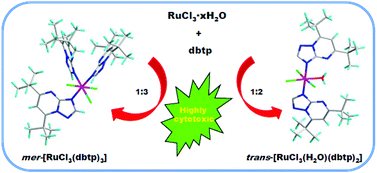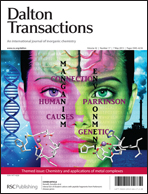Two ruthenium(III) complexes composed of 5,7-ditertbutyl-1,2,4-triazolo[1,5-a]pyrimidine (dbtp) ligands were prepared and structurally characterized by X-ray crystallography, IR, UV-Vis, EPR spectroscopies and cyclic voltammetry (CV). The crystal structures of trans-[RuCl3(H2O)(dbtp)2] 1 and mer-[RuCl3(dbtp)3]·0.815OCMe22 showed slightly distorted octahedral geometries with two 1 or three 2 monodentate dbtp ligands bound in a head-to-head orientation. In both complexes, the heterocyclic dbtp ligands were bound to the ruthenium(III) ion through the N3 nitrogen atom. A cytotoxicity assay of both ruthenium(III) compounds against two human cell lines (A549 – non-small cell lung carcinoma and T47D – breast carcinoma) was performed. The ruthenium(III) complexes showed excellent cytotoxicity with IC50 values in the range of 0.02–2.4 μM against both cancer cell lines. In addition, the in vitro cytotoxic values of the ruthenium(III) compounds were 35-times for 1 and 172-times for 2 higher against T47D than the clinically used antitumor drug cisplatin.

You have access to this article
 Please wait while we load your content...
Something went wrong. Try again?
Please wait while we load your content...
Something went wrong. Try again?


 Please wait while we load your content...
Please wait while we load your content...